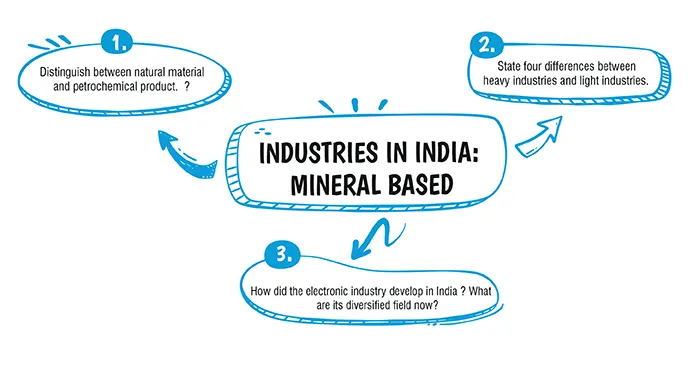Table of Contents

Ans. (b) Iron and steel industry
Explanation:
Iron and Steel industry is the largest mineral based industry
| Petrochemical production Unit | location | ||
|---|---|---|---|
| (I) | Herdillia chemical lTD | (i) | West Bengal |
| (II) | National organic Chemicals industries LTD | (ii) | Vadodara |
| (III) | Petrofils cooperative LTD | (iii) | Mumbai |
| (Iv) | Haldia Petrochemical industries | (iv) | Chennai |
Ans. (b) (I)-(iv), (II)-(iii), (III)-(ii), (IV)-(i)
Explanation:
• There are many petrochemical production units in India. Some of them are as follows:
• Herdillia Chemicals Ltd. in Chennai.
• National Organic Chemicals Industries Ltd. near Mumbai.
• Petrofils Cooperative Limited (PCL) in Vadodara.
• Haldia Petrochemical Ltd. in West Bengal.
Explanation:
| Natural Materials | Petrochemical Product |
|---|---|
| (i) Leather footweat | Plastic sleepers, synthetic footwear |
| (ii) Natural Rubber | Synthetic rubber |
| (iii) Jute Fibre | Synthetic fibre |
| (iv) Steel Pipes | PVC |
Explanation:
| Heavy Industries | Light Industries |
|---|---|
| 1. Require heavy machinery with raw material in large quantities. | Light raw materials and light machinery is required. |
| 2. Engage many skilled workers. Women and children are generally not employed. | Engage few workers. Women and children are also employed. |
| 3. Huge capital is required. | Less capital is required. |
| 4. Finished products are heavy in weight, e.g., iron and steel, cotton textiles, fertilisers, locomotives and automobiles. | Finished products are light in weight, e.g., drugs, pharmaceuticals and electrical appliances. |
Explanation:
Electronic industry developed in India in 1950. It started with the manufacturing of radio sets and now it has spread all over India in various diversified fields such as defence equipment, medical diagnosis, communication, information technology, computer system, space exploration. Indian hardware and software is in great demand worldwide.
Download Mind Map of this chapter
Download NowWant to Practice Mock Tests of this chapter
Practice NowDownload Important Questions of this chapter
Download Now| Chapter No. | Chapter Name |
|---|---|
| Chapter 1 | Map Study: Interpretation of Topographical Maps |
| Chapter 2 | Map of India |
| Chapter 3 | Location, Extent and Physical features |
| Chapter 4 | Climate of India |
| Chapter 5 | Soil Resources |
| Chapter 6 | Natural Vegetation of India |
| Chapter 7 | Water Resources |
| Chapter 8 | Mineral and Energy Resources |
| Chapter 9 | Agriculture In India |
| Chapter 10 | Industries in India: Agro Based |
| Chapter 11 | Industries in India: Mineral Based |
| Chapter 12 | Transport in India |
| Chapter 13 | Waste Generation and Management |
CBSE Important Questions Class 10
ICSE Important Questions Class 10
CBSE Important Questions Class 10
ICSE Important Questions Class 10